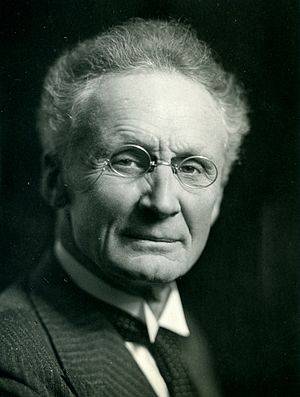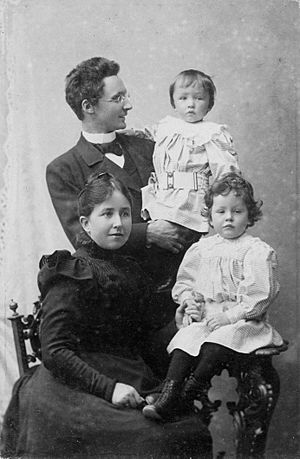Vilhelm Bjerknes facts for kids
Quick facts for kids
Vilhelm Bjerknes
|
|
|---|---|

Vilhelm Bjerknes, circa 1920
|
|
| Born | 14 March 1862 Christiania, Norway
|
| Died | 9 April 1951 (aged 89) Oslo, Norway
|
| Citizenship | Norwegian |
| Known for | Poincaré–Bjerknes circulation theorem Bjerknes force Primitive equations Development of modern weather forecasting Bergen School of Meteorology |
| Awards | Gunnerus Medal (1938) Buys Ballot Medal (1933) ForMemRS (1933) Symons Gold Medal (1932) Fridtjof Nansen Prize (1908) |
| Scientific career | |
| Fields | Physics and Meteorology |
| Institutions | University of Stockholm University of Leipzig University of Oslo |
| Doctoral advisor | Heinrich Hertz |
| Doctoral students | Harald Sverdrup |
| Influences | Heinrich Hertz Henri Poincaré Carl Anton Bjerknes |
| Signature | |
Vilhelm Friman Koren Bjerknes (born March 14, 1862 – died April 9, 1951) was a brilliant Norwegian scientist. He was a physicist and a meteorologist, which means he studied how weather works. He is famous for helping to create modern weather forecasting. Bjerknes came up with important mathematical rules called the primitive equations. These rules are still used today to predict weather and understand Earth's climate. He also started a new way of thinking about weather, known as the Bergen School of Meteorology, which greatly improved weather prediction in the early 1900s.
Contents
A Young Scientist's Journey
Vilhelm Bjerknes was born in Christiania, Norway (now called Oslo). From a young age, he was interested in how liquids and gases move, a field called fluid dynamics. He learned a lot by helping his father, Carl Anton Bjerknes, who was also a scientist. His father had studied how objects moving in a fluid could affect each other from a distance, similar to how magnets work.
When Vilhelm was about 17 or 18, he built special tools to show his father's ideas in real life. He used spheres, discs, and membranes vibrating in a thick liquid, like syrup. These experiments showed how things like electricity and magnetism could be explained by the movement of fluids. His demonstrations were a big hit at a science fair in Paris in 1881 and amazed scientists worldwide.
Exploring Electricity and Waves
From 1890 to 1891, Vilhelm Bjerknes worked with Heinrich Hertz in Germany. Hertz was a famous scientist who studied electromagnetic waves, which are like radio waves. Bjerknes helped Hertz understand a puzzle called "multiple resonance." This is when an electrical circuit responds strongly to several different frequencies of waves.
Later, back in Norway, Bjerknes continued his experiments. He showed how the type of metal used in electrical wires affects how electricity moves through them. He also measured how deep electric waves could go into different metals. This is known as the "skin effect." His work on electric waves was very important for developing wireless telegraphy, which was an early form of radio communication.
Weather Forecasting Breakthroughs
In 1895, Bjerknes became a professor at the University of Stockholm in Sweden. Here, he focused on how fluid dynamics and thermodynamics (the study of heat and energy) are connected. His most important contribution was creating the primitive equations. These are a set of mathematical rules that describe how the atmosphere and oceans move.
These equations were a huge step forward. They inspired other scientists, like V. Walfrid Ekman and Carl-Gustav Arvid Rossby, to use them to understand large-scale movements in the oceans and the atmosphere. This work made modern weather forecasting possible. Bjerknes himself saw the potential of his equations for weather prediction as early as 1904.
His research was supported by the Carnegie Institution in Washington, D.C. In 1913, he published two important books, Statics and Kinematics, which were part of a larger work on weather and ocean dynamics.
In 1906, Bjerknes also described and mathematically explained forces that act on bubbles in sound waves. These are now known as Bjerknes forces.
Leading the Bergen School
In 1907, Bjerknes returned to the Royal Frederick University in Oslo. Then, in 1912, he became a professor of geophysics at the University of Leipzig in Germany. He started publishing detailed weather maps of Europe in 1916.
In 1917, he founded the Geophysical Institute, University of Bergen in Norway. Here, he wrote another important book and created the Bergen School of Meteorology. This wasn't a school building, but a new way of thinking about how to predict weather using scientific methods. He developed a much better and more scientific weather service. His son, Jacob Bjerknes, who was also a meteorologist, later continued his father's work.
Vilhelm Bjerknes retired in 1932. He was recognized by many scientific groups, including the Royal Swedish Academy of Sciences and the Royal Society. He also received the Symons Gold Medal in 1932 for his work in meteorology.
He passed away in Oslo. In 1893, he married Honoria Bonnevie, who often helped him with his scientific studies. Their son, Jacob Aall Bonnevie Bjerknes, followed in his footsteps and became a famous meteorologist too.
To honor his contributions, two craters are named after him: one on the Moon and one on Mars.
See also
 In Spanish: Vilhelm Bjerknes para niños
In Spanish: Vilhelm Bjerknes para niños



